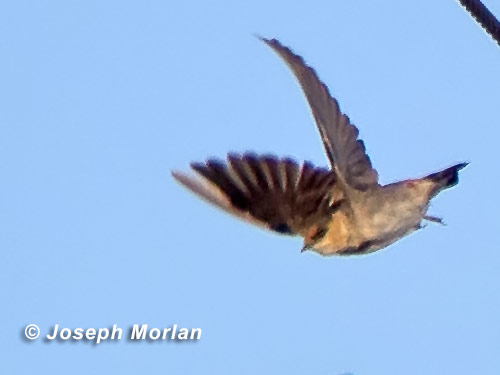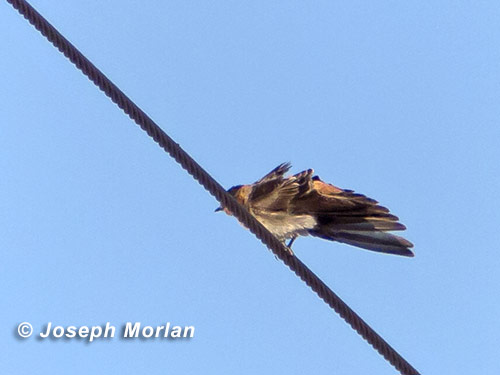Cave Swallows (Petrochelidon fulva)
Pound Road, Niland, Imperial County, CA
28 March 2013
Joseph Morlan
Photos © 28 March 2013 by Joseph Morlan. All rights reserved. Click here for larger images.
 Dan Singer and I thought it would be a good idea to drive all day to
reach the south end of the Salton Sea to look for up to four Cave Swallows which were known to be present in the
area. We met Guy McCaskie, Therese Clawson and Dave Quady in Calipatria early in the morning at 28 March and arri
Dan Singer and I thought it would be a good idea to drive all day to
reach the south end of the Salton Sea to look for up to four Cave Swallows which were known to be present in the
area. We met Guy McCaskie, Therese Clawson and Dave Quady in Calipatria early in the morning at 28 March and arri ved at
the old gun club on Pound Road about 7am. There were no swallows present at that time. We waited for about 15 minutes
when a single Barn Swallow flew by, then another Barn Swallow and soon a single Cave Swallow flew over the road.
By about 7:30am a good flock of Tree and Barn Swallows had landed on the wires and at least two Cave Swallows also
landed with them. In addition were a few Cliff and Bank swallows.
ved at
the old gun club on Pound Road about 7am. There were no swallows present at that time. We waited for about 15 minutes
when a single Barn Swallow flew by, then another Barn Swallow and soon a single Cave Swallow flew over the road.
By about 7:30am a good flock of Tree and Barn Swallows had landed on the wires and at least two Cave Swallows also
landed with them. In addition were a few Cliff and Bank swallows.
I attempted to photograph the Cave Swallows using digiscoping with the results seen here.
Description
The following description is based on memory and on photos:
These were small swallows with very short square tails. They had a peach-colored rump similar to that of
Cliff Swallow. However, the head pattern was quite different from that of Cliff Swallow. The throat was tawny or
reddish brown in color blending with a grayish was across the the chest. The tawny color extended along the side
of the face under the eye and wrapped up to the back of the ear coverts. In flight the underpart pattern recalled
that of Rough-winged Swallow.
The forehead was slightly darker than the throat and the reddish-brown color there was rather ill-defined.
On one bird, the rusty forehead seemed to extend further back over the eye making the eye stand out more. The rest
of the crown was dusky or dark gray. The back and wings were a dark gray, almost charcoal color except for the
edges of the tertials which were white on one individual. Another seemed to have more extensive white mottling
on the tertials.
The back was dark gray, but when the birds were observed preening, pale gray spotting or streaking appeared
on the mantle. This pattern was ephemeral, appearing only when the feathers were fluffed. The wings were long and
pointed, appearing black on the upperside and gray on the underside. On one bird the outer primary appeared to
be much paler than the others suggesting a molt limit (see flight shot). The rest of the underparts were whitish
with a tinge of orange on the flanks. Legs were short and gray. Feet were gray.
Legs were short and gray. Feet were gray.
Discussion
Identification
Cave Swallows can be confused with the southwestern race of Cliff Swallow (Petrochelidon pyrrhonota melanogaster)
which has a dark forehead, but Cliff Swallows always have a dark chestnut colored throat. Seldom discussed
is Chestnut-collared Swallow (Petrochelidon rufocollaris) of South America. It resembles Cave
Swallow but has its underparts mostly white, with a rufous breast band and flanks. It is also non-migratory and
unlikely to be occur naturally in North America.
Subspecies
These birds appear to be the Texas and Mexican race P. f. pallida (P. f. pelodoma is a synonym).
These birds are duller than the various races found in the Caribbean (P. f. fulva group) which typically
show a darker rufous rump and throat and a distinct rufous wash to the sides, flanks, and undertail coverts. Also
Texas/Mexican birds appear t o be responsible for most US records away from the Southeast.
o be responsible for most US records away from the Southeast.
Age
The mixture of old and new primary feathers on at least one bird suggests that it was hatched in 2012.
Status in California
There are four previously accepted records of this species in California, all involving single birds in Imperial
County.
Two birds were found nearby at Schrimpf and Davis Roads 18 December 2013 and are likely the same individuals
currently at Pound Road where two birds were seen first on 12 March 2013 with a maximum of four individuals being
reported.
Although our group decided we saw a minimum of two birds, I feel the photos support a third bird. There are
two birds with a more bug-eyed look (both in photo on the left) where the eyes contrast with orange; there is one
bird in which the eye appears to be less obvious with more extensive dark over the eye (top photo). The photo on
the left shows two Cave Swallows, two Barn Swallows and a single Cliff Swallow together.
External Links
 Dan Singer and I thought it would be a good idea to drive all day to
reach the south end of the Salton Sea to look for up to four Cave Swallows which were known to be present in the
area. We met Guy McCaskie, Therese Clawson and Dave Quady in Calipatria early in the morning at 28 March and arri
Dan Singer and I thought it would be a good idea to drive all day to
reach the south end of the Salton Sea to look for up to four Cave Swallows which were known to be present in the
area. We met Guy McCaskie, Therese Clawson and Dave Quady in Calipatria early in the morning at 28 March and arri ved at
the old gun club on Pound Road about 7am. There were no swallows present at that time. We waited for about 15 minutes
when a single Barn Swallow flew by, then another Barn Swallow and soon a single Cave Swallow flew over the road.
By about 7:30am a good flock of Tree and Barn Swallows had landed on the wires and at least two Cave Swallows also
landed with them. In addition were a few Cliff and Bank swallows.
ved at
the old gun club on Pound Road about 7am. There were no swallows present at that time. We waited for about 15 minutes
when a single Barn Swallow flew by, then another Barn Swallow and soon a single Cave Swallow flew over the road.
By about 7:30am a good flock of Tree and Barn Swallows had landed on the wires and at least two Cave Swallows also
landed with them. In addition were a few Cliff and Bank swallows. Legs were short and gray. Feet were gray.
Legs were short and gray. Feet were gray. o be responsible for most US records away from the Southeast.
o be responsible for most US records away from the Southeast.